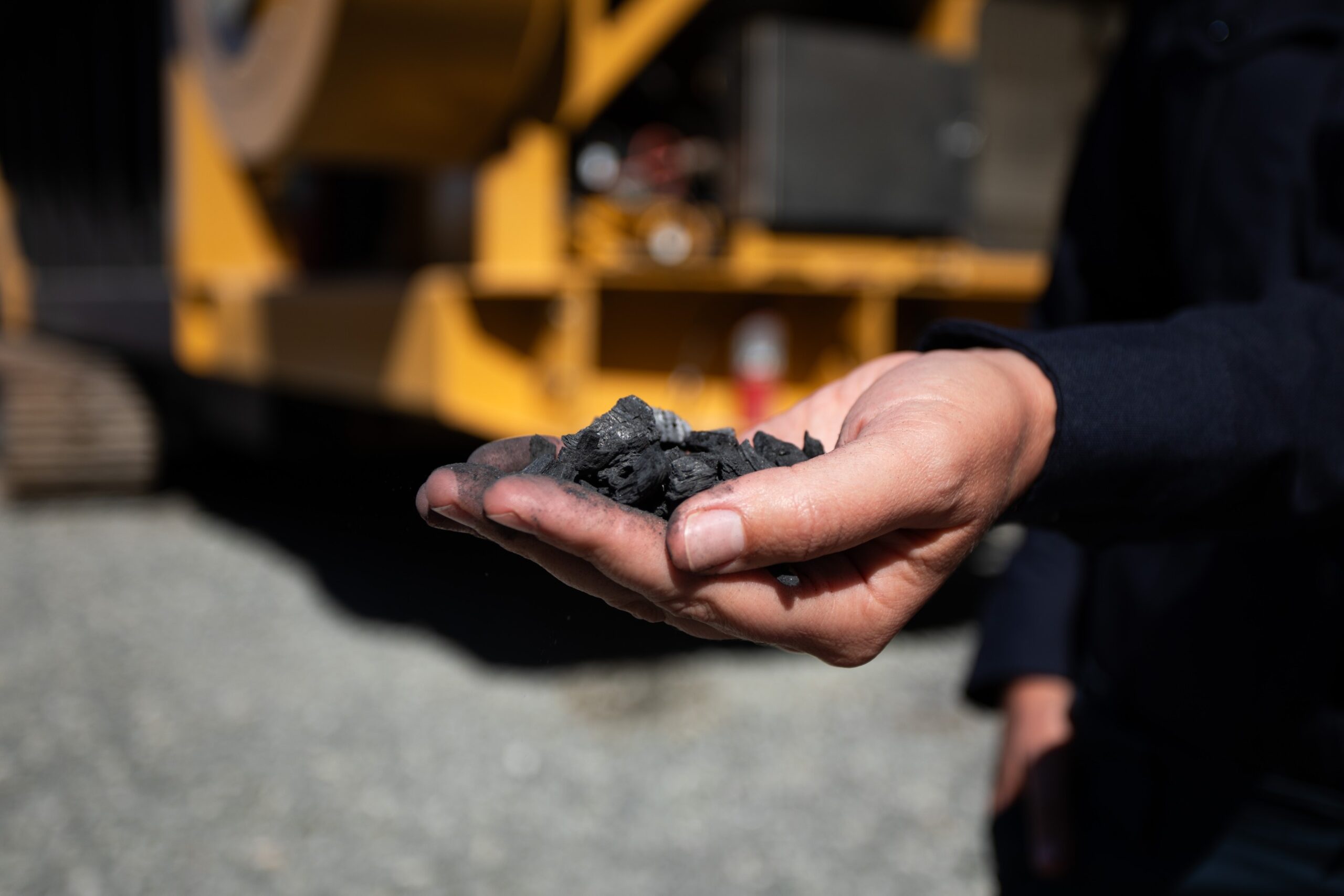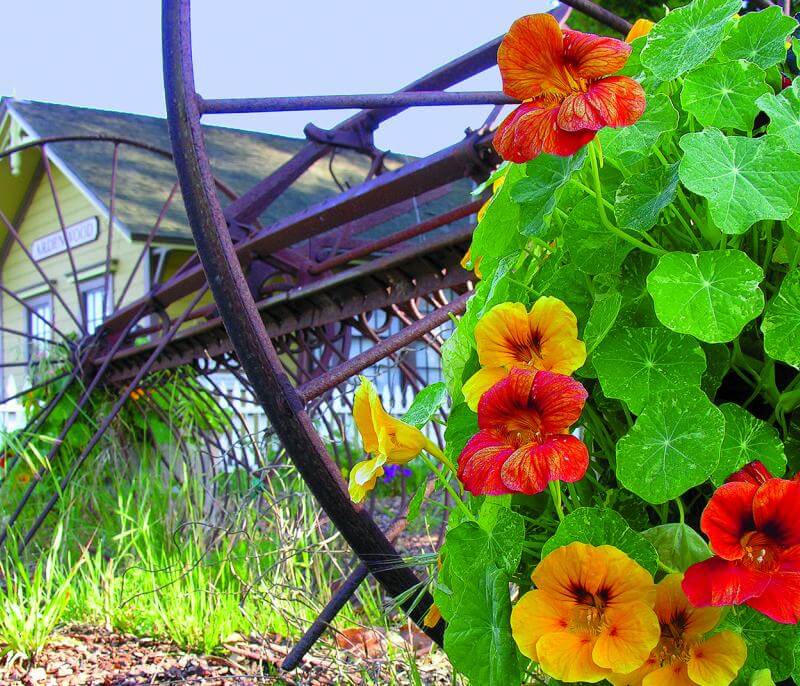Since 2022, Sonoma Ecology Center has worked with Earth Foundries as a consultant on numerous initiatives to study ways biochar can be used to improve soil health and provide other ecological benefits beyond Sonoma Valley.
The Earth Foundries team successfully wrapped up this summer a major project in this series of initiatives: a 365-acre fuel reduction project at Anthony Chabot Regional Park, part of the East Bay Regional Park district. This project produced 585 tons of biochar out of eucalyptus forests, an invasive species, at Anthony Chabot Regional Park, which were used for ecological benefits at sites across East Bay Regional Parks.

Raymond Baltar, SEC’s Climate and Biochar Project Manager on a site visit to a rangeland area at Briones Regional Park, part of the East Bay Regional Park District. Raymond and the CEO of Earth Foundries, Roger Smullen, met with four park staff to discuss the use of biochar in some of the 86,000 acres of rangeland contained within the park system, as well as in other areas being restored throughout the park system. Photo courtesy of Raymond Baltar.
Working with SEC and Earth Foundries were the East Bay Regional Park District, California Climate Investments, Falk Forestry, Ascent Forestry, and CalRecycle. The project used western Sonoma forester Dan Falk’s (Falk Forestry) Tigercat Carbonizer, which processed all of the wood from fuel reduction into biochar.
At Anthony Chabot Regional Park, Earth Foundries’ team used 10 tons of biochar produced on site to prevent stormwater pollution, control erosion, and as an amendment for row crop and native plants. At Dry Creek Pioneer Regional Park in Union City, we used 11 tons of biochar for soil restoration from storm damage, and as a vegetable garden soil amendment. We used much of the biochar — 427 tons — as a farmland soil amendment at Ardenwood Historic Farm in Fremont.
“The project at Anthony Chabot Regional Park is a first-of-its-kind project in the Bay Area,” said Park District General Manager Sabrina Landreth. “As the largest regional park district in the nation and a local leader in wildfire prevention, we knew we needed to find an innovative solution for disposing of the vegetation from our fuels reduction projects.”
General Manager Landreth says she is thrilled with the pilot project results. “We were able to show that you can actually remove these dead and dying standing trees to keep our communities safe — and with all the benefits that we get from not having to haul this biomass around, not to mention what the benefits will be from the biochar itself.”

Anthony Chabot Regional Park, where our coalition led by Earth Foundries used spare wood materials from wildfire risk reduction efforts to create biochar for beneficial reuse. Photo courtesy of Cali Godley/East Bay Regional Park District.
“The carbonizer is an innovative fuels reduction tool to address wildfire risks and combat climate change,” says East Bay Regional Park District Fire Chief Aileen Theile. “We are always looking for innovative ways to address wildfire dangers and reduce wildfire risks for the community.”
“Research done by the Marin Carbon Project and UC Berkeley has shown that spreading compost on rangelands can improve soil conditions, leading to increased grass production for grazing animals and increased soil water retention. The longer a field stays green in the Spring, the less money a dairy farmer, for example, has to spend on animal feed over the summer months and the more silage he or she can produce themselves,” shares Raymond Baltar, SEC’s Climate and Biochar Projects Manager.

Biochar created from biowaste from fuel reduction efforts at Anthony Chabot Regional Park. Photo credit: Cali Godley/East Bay Regional Park District.
Raymond continues, “Biochar, especially when blended with compost (and/or other natural nutrients), has been shown to enhance plant production and we believe the two soil amendments used together would further increase grass root and plant production. Our goal in the East Bay Regional Park District project is to test the theory that when biochar is blended with compost or other natural nutrients, it can enhance plant production. So the park district blended biochar and compost and applied it to restore and regenerate depleted rangeland areas within the park system.”

Ardenwood Historic Farm in Fremont. 427 tons of biochar created from the Anthony Chabot State Funded Fuel Reduction Project was used here as farmland soil amendment. Photo courtesy of East Bay Regional Park District.
“A huge percentage of the various parkland acreage East Bay Regional Park District manage is rangelands leased to ranchers, While it was estimated that perhaps only 5% of this land is considered depleted and unproductive, the total acreage that could be treated and improved is significant,” Raymond shares.
Roger Smullen, CEO of Earth Foundries, shares, “Earth Foundries has worked with SEC on our US Forest Service and CAL FIRE funded biochar market development projects, and were well aware of Raymond’s deep experience with biochar. Earth Foundries greatly appreciates Raymond’s work on the report we delivered on how the park district could incorporate biochar into park operations, and it is heartening to see the park district utilizing biochar from their hazardous fuels reduction projects in many of the ways we recommended in the report.”
The 400-acre project based at Anthony Chabot Regional Park was funded by Valley Water, US Forest Service and CAL FIRE. Starting July 2024 and continuing through winter 2025, the Earth Foundries team will continue the project on another 180 acres in the East Bay Regional Park District.
